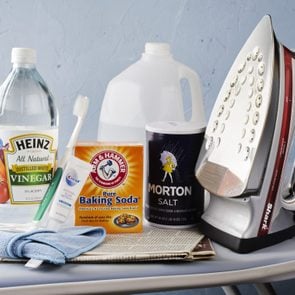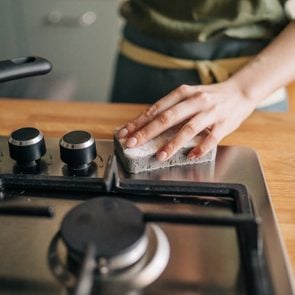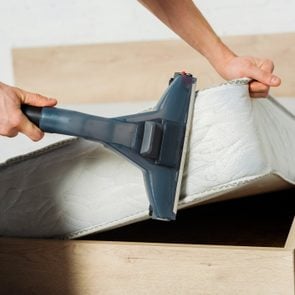How to Clean a Humidifier, According to Experts
Updated: Feb. 15, 2023
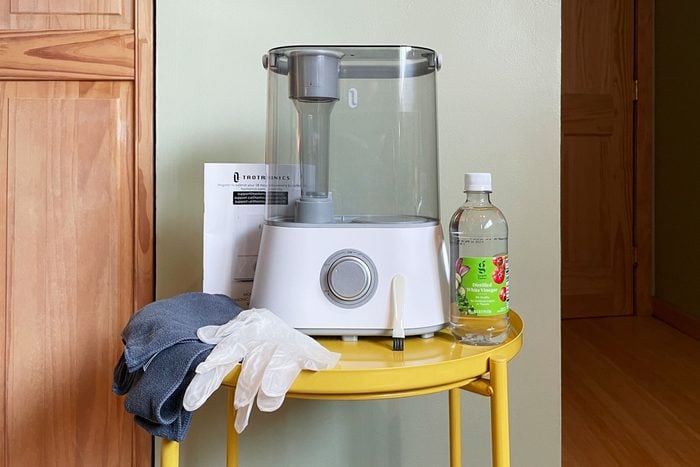
Yes, you need to clean your humidifier regularly. Here's how.
Keeping a humidifier running—especially during the winter months—can be a game-changing health habit. Adding a little bit of moisture into your home’s dry air can help with everything from the prevention of bloody noses and cracked lips to dry skin and eczema. Yet according to an informal survey conducted by Consumer Reports, 59 percent of respondents who use a humidifier said they do not clean it every day, and one in four people clean theirs twice a month or less. Not shocking, considering many of us don’t want to bother learning how to clean a humidifier or commit the time to proper maintenance.
But experts warn that even the best humidifiers need to be cleaned—and not just at the end of winter. The reason has to do with how a humidifier works. “By its nature, there is water passing through a humidifier,” explains John McKeon, MD, CEO and founder of Allergy Standards. “The user fills the water tank, then the humidifier will disperse this water into the air in the room to increase the water content in the air.”
Anytime there is stagnant water, the growth of bacteria and mold is a possible scenario. “If the water is not refreshed regularly, you risk spraying infected water into your home,” he explains. This is why it’s not only important that your humidifier has a sanitization function to neutralize any mold before it can be released into your room but that you also clean the humidifier regularly to ensure there is no buildup of mold or other particles. Luckily, cleaning a humidifier is easy, and you probably already have everything you need to do it at home. When you’re done, be sure to do a deep clean on other household items, like your shower head and air purifier.
How to clean a humidifier
Before starting the cleaning process, gather these supplies:
- Your owner’s manual. “Different models have different recommended methods of cleaning,” says Dr. McKeon, so always check your manual first. Here’s why it’s a mistake to use bleach on certain parts of your humidifier.
- A small brush. A little brush, even a toothbrush, will help you clean hard-to-reach spots. This small brush set comes with everything you need to clean your humidifier and nearly every other odd appliance and gadget in your home.
- Disinfectant. This can include bleach, vinegar, or a hydrogen peroxide solution.
- Gloves and goggles. If you are working with any harsh chemicals, you should always protect your hands and eyes, Dr. McKeon points out.
Once you have your supplies on hand, follow the steps below to clean your humidifier.
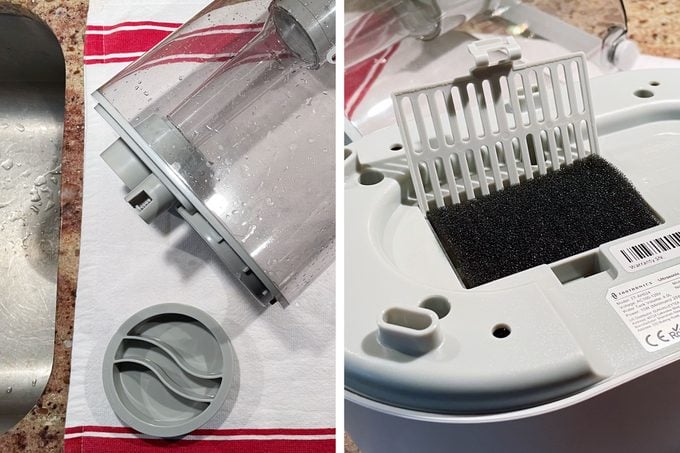
- Empty the tank. Whether you are just cleaning it so that you can reuse it immediately or plan on storing your humidifier for the season, make sure to empty all existing fluid from the unit.
- Check filters. Prior to cleaning, remove any filters. Replace your dirty filters. Once you are done using your humidifier for the season, dispose of any humidifier filters or cartridges before storing your appliance. You will want to start fresh next winter.
- Clean the unit. Using a small brush and wearing gloves and goggles, clean the unit with the recommended disinfectant, making sure to remove all mineral deposits from the tank.
- Rinse the unit thoroughly. “If you use a weak bleach solution, vinegar, or any other chemicals suggested by the manufacturer, make sure you rinse the tank several times after cleaning so that these chemicals are not spread into the air when you switch on the humidifier,” Dr. McKeon says.
- Dry the unit thoroughly. After cleaning—and especially if you are planning on storing it—make sure to dry the unit thoroughly. You can do this with a towel or allow it to air dry.
- Refill with water. Once clean and dry, your unit is ready to use again. Follow the instructions to fill with water.
- Sanitize the water. Dr. McKeon recommends selecting a humidifier with a sanitizing function. After refilling, run the sanitizing cycle. “This means that the water is sanitized in the machine before it is released into the air, using UV or other technology, which will deactivate any mold or bacteria in the water,” he explains.
- Repeat the process regularly. Dr. McKeon reiterates that regular cleaning of your humidifier will ensure that your air will be cleaner and free of any mold or bacteria. Here are other places bacteria and germs can hide in your home.
How to disinfect a humidifier
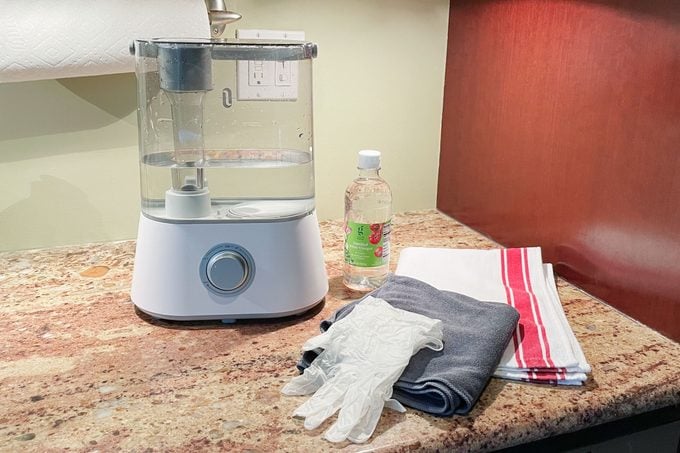
Disinfecting your humidifier involves the same tools, but the process is a bit more labor intensive, explains air quality expert and international mold expert Michael Rubino, president of All American Restoration and author of The Mold Medic. You’ll accomplish this task in two steps: disassembling the machine and disinfecting with vinegar.
1. Take the machine apart
The first and easiest step is to disassemble all of the parts of the humidifier, starting by unplugging the machine. “From there, taking it apart usually just involves popping out the tank, emptying the water, sliding out the filter, and removing the extra parts, like the housing tray,” Rubino explains. This is one of the reasons why having an instruction manual handy is important; you can check the manufacturer’s instructions on how to disassemble each part.
2. Soak and cycle with white vinegar
Vinegar, which anyone who has cleaned a coffee maker knows, is a descaler, helping remove layers of particles from a surface. It also helps prevent mold and bacterial growth, according to Rubino. “Killing mold isn’t the complete answer, because some particles remain on the surfaces,” he says. “You need something to discourage mold growth, strip particles away from the surface, and actively eliminate mineral buildup. The buildup is what mold spores eat and use for survival and continued growth.”
Here’s how to do that:
- Pour enough vinegar into the tank to cover the area the water typically fills.
- Swish the vinegar around a bit to make sure it hits every single surface and then let it sit for about half an hour.
- After soaking, put the tank back on the base and let the vinegar filter into the reservoir (if applicable). Let that sit for another 30 minutes.
- Rinse thoroughly to make sure all traces of vinegar are removed.
- Wipe down both pieces with a microfiber towel and leave them to dry out completely. “Use microfiber towels during the entire cleaning process because they are 100 times more effective at trapping particles than other towels,” Rubino says.
While you’re going through these steps, soak the other disassembled parts in a vinegar solution for about 30 minutes.
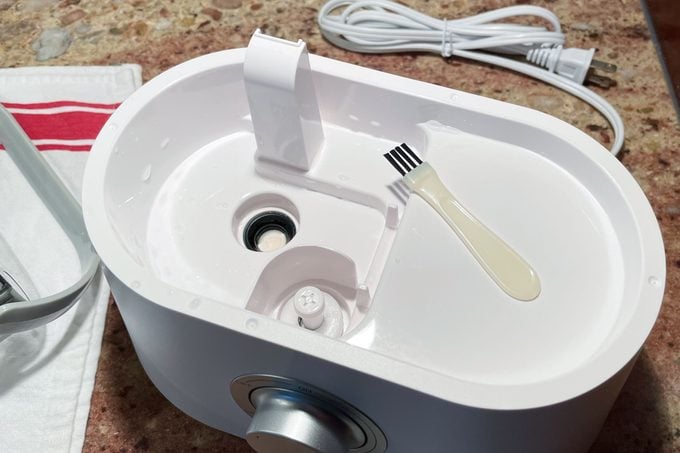
3. Scrub everything inside
Why is it important to clean all of the tiny pieces inside your humidifier? “These can have dirt, mineral, or water buildup, which is an excellent place for mold to grow,” Rubino says. “Mold spores and bacteria could have also made their way inside the machine.” Clean them by following these steps:
- Using a small, soft-bristled brush coated in white vinegar, scrub down all of the tiny parts inside the humidifier. “A spare toothbrush is an easy option to use,” he notes. Rinse with water. Wipe with a microfiber towel and then allow the parts and surfaces to dry.
- Tackle any crevices or inner areas next with a brush, and make sure to wipe them down and provide proper drying time.
- Lightly scrub the parts you’ve been soaking with a brush to remove any residue. Rinse them thoroughly, wipe them with a microfiber towel, then set them out to dry completely.
4. Wipe down the outside
The outside can get just as dirty as the inside. “Use EPA-approved cleaning products like Benefect Decon 30 to clean and disinfect every nook and cranny of the outside,” Rubino suggests.
Using the microfiber towel, wipe down these surfaces at least three times to make sure they’re completely clean. “Three times might seem like overkill, but mold spores aren’t the only thing you have to worry about when it comes to exposure,” he says. “Many mold species can also create microscopic toxins, called mycotoxins, that they release into the air and can stick to any surfaces they come in contact with.”
How often should you clean a humidifier?
How often you should clean your humidifier varies by model, with most specifying recommendations in the instruction manual. You’ll certainly want to clean it when you notice it’s dirty on the inside or out. And if you’re going to put it in storage or stop using it for a few months, clean it and make sure there is no water left in the tank before putting it away, then clean it when you’re ready to use it again, Dr. McKeon instructs.
Can a dirty humidifier make you sick?
Failing to clean your humidifier can negatively impact your health and make you sick. Dirty reservoirs and filters in humidifiers are prone to breeding bacteria and mold, which can be especially detrimental to those with asthma and allergies, according to the Mayo Clinic. But even those without any health issues may experience complications from using a dirty humidifier and inhaling contaminated mist or steam, including flu-like symptoms or even lung infections.
So while moist air can help your health, moldy air can harm it. “Mold loves warm, moist environments, which is exactly what a humidifier creates,” says Rubino. “Once mold starts to grow inside the machine, it’s not just moist air that will be pumped into a home. Moldy, wet air will begin circulating throughout the house.”
When should you replace a humidifier?
The good news is that if you stick to the recommended cleaning instructions, your humidifier should last a long time, Dr. McKeon says. But there are a few situations in which you should consider investing in a new one:
- Your machine breaks. The obvious reason to invest in a new humidifier is if yours is broken.
- It’s not efficient. If your unit isn’t hydrating the air properly, it is time for an upgrade. You can figure this out by investing in an inexpensive device called a hygrometer, which measures the relative humidity in a room. “Ideally, you want the humidity to be between 30 and 60 percent,” Dr. McKeon says. “It is possible for air to become too humid if you leave the humidifier running continually without monitoring humidity, and this can encourage the growth of mold and bacteria in the room as well as shorten the life of your humidifier.”
- It isn’t the appropriate size. Size matters when it comes to a humidifier. “It is important to choose a humidifier that is appropriate for the size of the room in which you intend to use it,” Dr. McKeon says. An easy way to check if your unit is sufficient for the room it is in is to read the instruction manual.
- It isn’t certified. It’s helpful to choose a humidifier that has been tested against some of the potential issues outlined above. “The Asthma and Allergy Friendly Certification standard for humidifiers tests that a humidifier can increase and maintain humidity in a room,” says Dr. McKeon. “The humidifier is also run in a sealed chamber with a contaminated water source to check that the sanitization function can remove any contamination before it reaches the breathing zone.”
How to keep a humidifier running well
A healthy humidifier means healthy air in the home. “Making sure your humidifier runs properly will avoid any maintenance issues that may cause malfunctioning,” says Rubino. Here are some other tips for maintaining your humidifier:
- Clean the filters as needed. Rubino stresses the importance of cleaning the air filter (if it has one) as often as the instruction manual dictates. “Checking the manufacturer’s recommendations is incredibly important because they’ll typically suggest a certain cleaning protocol. Not following their suggestions could damage the filter and make it ineffective,” he says. Cleaning the filter for most humidifiers involves placing it under running water and gently using a brush to remove any dust. “If there’s mold, it’s best to replace the filter to completely ensure the mold growth will not return and continue,” he says. “This cleaning process should typically be completed once a week.”
- Replace air filters as needed. Regularly changing the filter is also incredibly important to make sure the humidifier filters out harmful particles properly. “Again, look at the manufacturer’s instructions to determine how often they need to be replaced,” says Rubino. “Typically it’s every 30, 60, or 90 days.”
- Use distilled water. Stick with distilled water as much as possible because tap water usually contains a high volume of minerals. “Not only will you avoid having minerals dispersed into the air along with water molecules, but you’ll also help prevent mineral buildup in the machine,” Rubino says. “Lower mineral buildup means fewer food sources for mold, which discourages growth.”
- Change the pad or water panel. Depending on your humidifier you may need to change the pad or water panel, says Rubino. “The manufacturer’s instructions will have a list of directions and timelines to follow,” he says.
| ♦ Humidifier Maintenance Tips |
While deep cleaning once a week can work wonders to keep your humidifier clean and your air quality healthy, there are other proactive steps to take, Rubino says. Be sure to:
|
Sources:
- Yahoo News: “Is Your Humidifier Putting You at Risk?”
- John McKeon, MD, CEO and founder of Allergy Standards
- Michael Rubino, president of All American Restoration and author of The Mold Medic

